
A cough in a child worries not only the baby, but also his parents, who seek to help their son or daughter in every way. Some begin to use folk recipes on the advice of relatives, others go to the pharmacy for syrup, and someone does inhalations. Let's figure out whose actions are correct in the opinion of a specialist, and how the popular pediatrician Komarovsky advises to treat a cough.

Symptomatic treatment
First of all, when a child of any age coughs, Komarovsky focuses the attention of parents on the fact that this is just a symptom of some diseaseaffecting the respiratory tract. In addition, this symptom is protective, so in most cases it should not be suppressed.
The popular doctor calls ARVI the main cause of cough in childhood. And therefore, in the overwhelming number of cases of cough in a child, eliminating its cause, according to Komarovsky, is impossible. But there is no need to leave the child without help, so a well-known pediatrician advises symptomatic treatment.
Wherein he calls the main principle of such a cough treatment not eliminating the symptom itself, but increasing the effectiveness of the cough. This can be achieved by influencing the quantity and quality of sputum using:
- Humid and cool air.
- Drink plenty of fluids.
For more details, see the program of Dr. Komarovsky.
Moisturizing and purifying the air
Komarovsky calls providing a child with moist and cool air one of the most important tasks of parents. it will reduce the load on the baby's respiratory tract, and also prevent the mucous membranes from drying out.
If you optimize the conditions in which the child is, his body will not spend efforts on air processing (heating, cleaning and humidifying it), but will focus on developing antiviral immunity.
In addition to temperature and humidity, a popular doctor pays attention to the need for clean air in the room where the coughing child stays. Komarovsky notes that children's need for clean air when coughing increases several times... This is primarily due to nasal congestion in acute respiratory infections and decreased activity of the epithelium in the respiratory tract. When dust enters the respiratory tract, it leads to impaired ventilation and additional phlegm production.
Komarovsky advises:
- Reduce the number of possible dust collectors in the room, for example, hide books behind glass, put toys in boxes, take out carpets.
- Avoid contact of the child with foreign smells and substances, for example, do not use deodorants and perfumes indoors, do not wash the floor with chlorine, do not spray insect repellent.
- Eliminate exposure of the child to tobacco smoke.
- Carry out frequent wet cleaning... A well-known pediatrician does not recommend vacuuming in a room with a sick child, and if the vacuum cleaner is used for cleaning, the child should be sent to another room while cleaning the room.
- Maintain the room temperature at +18 degrees.
- Maintain indoor humidity at 60-70%. The best choice would be to use a humidifier, but if there is no such device in the family, Komarovsky recommends using containers with water and wet sheets.
It is especially important to maintain optimal temperature and humidity levels at night. This will be the prevention of a night cough caused by dry mucous membranes and staying in a supine position, as well as cough after sleep.

Give your child more to drink
According to Komarovsky, Drinking plenty of fluids for a child with a cough is irreplaceable. It will support and restore the properties of phlegm, affecting blood rheology, that is, first drinking will make the blood thinner, which will increase blood circulation in the mucous membranes of the respiratory system and improve their ability to form normal mucus. In addition, the child's body spends a lot of fluids at elevated temperatures and rapid breathing, which also necessitates frequent drinking.
So that the drunk liquid is absorbed faster, Komarovsky advises to give any drink heated to about body temperature... In this case, the liquid will immediately be absorbed in the stomach and enter the bloodstream.
As for the drinks themselves, the child can be given:
- Rehydration solutions.
- A weak tea, it is possible with sugar and safe fruits.
- Dried fruits compote.
- Infusion of raisins (insist a tablespoon of raisins, filled with 200 ml of water for 30-40 minutes).
- Compote of berries and fruits that the child tried before the illness.
- Fruit drink or juice.
- Still mineral water with a neutral taste.
- Watermelon.


Komarovsky calls rehydration solutions the best choice to drink, however, at a body temperature of up to + 38 ° C, sufficient air humidification and the absence of breathing problems, the child's wishes can be guided.
The popular doctor advises babies with a cough to drink in addition to breastfeeding, since breast milk does not cover pathological waste of fluid. At an early age, the baby can be given a rehydration solution, baby tea, still mineral water and raisin decoction.

You need to water the baby more actively if:
- Indoor air is dry and warm.
- The child's body temperature is high.
- Urination is infrequent and the urine is darker than usual.
- There is severe shortness of breath and dry cough.
- The skin and mucous membranes are dry.
With a slight deterioration in the condition, low temperature, as well as access to cool and humid air, Komarovsky calls the child's thirst as the main criterion for the frequency of drinking. At the same time, you need to offer a drink very often and at every opportunity. Drinking support is also important when a child has a lingering and residual cough.
Drug treatment
Komarovsky calls the appointment of any medicines to children with coughs the prerogative of a doctor. This is especially true for coughing in infants.
Protic drugs
Since the cough is a necessary protective reflex, in most cases such medications are not needed. Komarovsky calls their appointment justified for whooping cough, when the child is tormented by coughing up to vomiting. Also, drugs that inhibit the cough reflex are needed for pleurisy, an oncological process in the respiratory tract and for an irritating cough caused by factors affecting the nerve endings.
Komarovsky is categorically against the independent prescription of antitussive drugs by parents to their children. He reminds that some drugs in this group are narcotic and can cause addiction. In addition, many antitussives can also depress the respiratory center, which is especially dangerous in children under 2 years of age. So, these drugs can be used in children over 2 years old only when indicated and after being prescribed by a pediatrician.
Expectorants
The popular pediatrician calls the main purpose of using such drugs to cleanse the respiratory tract from sputum. It is very dangerous, according to Komarovsky, to combine such medicines with antitussives, because in such cases the phlegm accumulated in the lungs will not cough up.
A well-known doctor divides all expectorants according to their mode of action into resorptive (they are absorbed in the stomach and secreted in the bronchi, affecting mucus) and reflex (they activate nerve endings in the stomach and affect the muscles of the bronchi and the production of mucus).
Most of the modern drugs are referred to as drugs with a reflex action. Komarovsky emphasizes that they are safe for children, but their effectiveness has not been proven, and the nature of the cough is more influenced by the conditions in which the child is found than any expectorant drugs.


Mucolytics
Such drugs affect the phlegm itself, changing its rheology. Komarovsky names ambroxol, bromhexine, carbocisteine, acetylcysteine and guaifenesin among the drugs in this group. A well-known doctor notes that it is advisable to use such drugs in the presence of viscous thick sputum. If the child has a mild variant of ARVI and has a wet cough, according to Komarovsky, mucolytics are not needed and can even intensify the cough. In addition, the effect of such drugs will be ineffective if the blood rheology is not additionally affected by drinking plenty of fluids.





